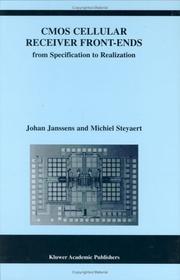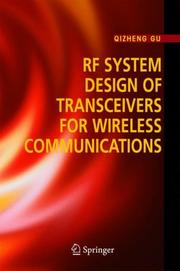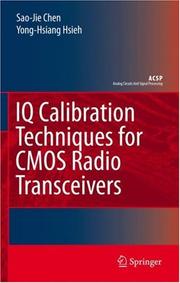| Listing 1 - 7 of 7 |
Sort by
|

ISBN: 1280207884 9786610207886 0306473046 0792376374 Year: 2002 Publisher: Boston, Mass. ; London : Kluwer Academic,
Abstract | Keywords | Export | Availability | Bookmark
 Loading...
Loading...Choose an application
- Reference Manager
- EndNote
- RefWorks (Direct export to RefWorks)
CMOS Cellular Receiver Front-Ends: from Specification to Realization deals with the design of the receive path of a highly-integrated CMOS cellular transceiver for the GSM-1800 cellular system. The complete design trajectory is covered, starting from the documents describing the standard down to the systematic development of CMOS receiver ICs that comply to the standard. The design of CMOS receivers is tackled at all abstraction levels: from architecture level, via circuit level, down to the device level, and the other way around. The theoretical core of the book discusses the fundamental and more advanced aspects of RF CMOS design. It focuses specifically on all aspects of the design of high-performance CMOS low-noise amplifiers.
Metal oxide semiconductors, Complementary. --- Mobile communication systems. --- Radio --- Transmitter-receivers. --- Systems engineering. --- Computer engineering. --- Circuits and Systems. --- Electrical Engineering. --- Electronic circuits. --- Electrical engineering. --- Electric engineering --- Engineering --- Electron-tube circuits --- Electric circuits --- Electron tubes --- Electronics --- Vehicles --- Vehicular communication systems --- Wireless communication systems --- CMOS (Electronics) --- Complementary metal oxide semiconductors --- Semiconductors, Complementary metal oxide --- Digital electronics --- Logic circuits --- Transistor-transistor logic circuits --- Radio transceivers --- Radio transmitter-receivers --- Transceivers --- Transmitter-receivers --- Communication systems
Book
ISBN: 3319033670 3319000977 3319000985 Year: 2013 Publisher: New York : Springer,
Abstract | Keywords | Export | Availability | Bookmark
 Loading...
Loading...Choose an application
- Reference Manager
- EndNote
- RefWorks (Direct export to RefWorks)
This book describes the design of ultra low power transceivers for body area networks. Since these applications have very limited energy resources, typically powered only by tiny batteries or through energy harvesting techniques, this book describes an architecture for a Bluetooth low energy transceiver to overcome these limitations. Coverage includes not only the main concepts for achieving low power consumption, but also the details of the circuit design and its implementation in a standard CMOS technology. · Guides readers through the design of ultra low power transceivers for body area networks, from architecture to circuit-level implementation; · Describes 4 key strategies for ultra-low power transceiver design and specific, innovative techniques for circuit-level design; · Enables readers to design transceivers for body area networks that are 27% more energy efficient than those currently available; · Includes a review of the state-of-the-art in low-power transceivers in the GHz frequency range.
Assistive computer technology. --- Low voltage integrated circuits. --- Radio -- Transmitter-receivers. --- Wireless communication systems in medical care. --- Electrical & Computer Engineering --- Engineering & Applied Sciences --- Electrical Engineering --- Radio --- Transmitter-receivers. --- Radio transceivers --- Radio transmitter-receivers --- Transceivers --- Transmitter-receivers --- Low power consumption chips --- Low power integrated circuits --- Reduced voltage integrated circuits --- Engineering. --- Electronic circuits. --- Electronics. --- Microelectronics. --- Circuits and Systems. --- Electronics and Microelectronics, Instrumentation. --- Electronic Circuits and Devices. --- Integrated circuits --- Low voltage systems --- Systems engineering. --- Electrical engineering --- Physical sciences --- Engineering systems --- System engineering --- Engineering --- Industrial engineering --- System analysis --- Design and construction --- Microminiature electronic equipment --- Microminiaturization (Electronics) --- Electronics --- Microtechnology --- Semiconductors --- Miniature electronic equipment --- Electron-tube circuits --- Electric circuits --- Electron tubes
Book
ISBN: 3662504383 3662504405 Year: 2016 Publisher: Berlin, Heidelberg : Springer Berlin Heidelberg : Imprint: Springer,
Abstract | Keywords | Export | Availability | Bookmark
 Loading...
Loading...Choose an application
- Reference Manager
- EndNote
- RefWorks (Direct export to RefWorks)
This book introduces systematic design methods for passive and active RF circuits and techniques, including state-of-the-art digital enhancement techniques. As the very first book dedicated to multiband RF circuits and techniques, this work provides an overview of the evolution of transmitter architecture and discusses current digital predistortion techniques. Readers will find a collection of novel research ideas and new architectures in concurrent multiband power dividers, power amplifiers and related digital enhancement techniques. This book will be of great interest to academic researchers, R&D engineers, wireless transmitter and protocol designers, as well as graduate students who wish to learn the core architectures, principles and methods of multiband RF circuits and techniques. .
Engineering. --- Microwaves. --- Optical engineering. --- Electrical engineering. --- Electronic circuits. --- Circuits and Systems. --- Microwaves, RF and Optical Engineering. --- Communications Engineering, Networks. --- Radio frequency integrated circuits. --- Radio --- Transmitter-receivers. --- Radio transceivers --- Radio transmitter-receivers --- Transceivers --- Transmitter-receivers --- RFICs (Integrated circuits) --- Electron-tube circuits --- Electric circuits --- Electron tubes --- Electronics --- Electric engineering --- Engineering --- Mechanical engineering --- Hertzian waves --- Electric waves --- Electromagnetic waves --- Geomagnetic micropulsations --- Radio waves --- Shortwave radio --- Construction --- Industrial arts --- Technology --- Integrated circuits --- Radio circuits --- Systems engineering. --- Telecommunication. --- Electric communication --- Mass communication --- Telecom --- Telecommunication industry --- Telecommunications --- Communication --- Information theory --- Telecommuting --- Engineering systems --- System engineering --- Industrial engineering --- System analysis --- Design and construction

ISBN: 1280311983 9786610311989 0387241620 0387241612 9780387241616 144193698X Year: 2005 Publisher: New York : Springer,
Abstract | Keywords | Export | Availability | Bookmark
 Loading...
Loading...Choose an application
- Reference Manager
- EndNote
- RefWorks (Direct export to RefWorks)
RF System Design of Transceivers for Wireless Communications is for RF Engineers and, in particular, those engineers focusing mostly on RF systems and RFIC design. The author develops systematic methods for RF systems design, complete with a comprehensive set of design formulas. Its focus on mobile station transmitter and receiver system design also applies to transceiver design of other wireless systems such as WLAN. The book is filled with detailed wireless systems design information, and addresses specifications that are critical for the design process. Additional highlights include: * Fundamental information on communications, signal and system theories * Coverage of superheterodyne, direct-conversion, low-IF, and band-pass sampling radio architectures * Frequency planning, system link budgeting, and performance evaluation of transmitters and receivers * Nonlinearity effect analyses involving intermodulation, interferer blocking, spectrum regrowth and modulation * Approaches for specifying RF ASICs on which mobile systems are built * AGC systems, ADC dynamic range consideration and power management are addressed * In-depth treatment of both theoretical and practical aspects of mobile station RF system design This comprehensive reference work covers a wide range of topics from general principles of communication theory, as it applies to digital radio designs to specific examples on implementing multimode mobile systems. Wireless engineering professionals will definitely find this an invaluable reference book.
Radio --- Wireless communication systems --- Transmitter-receivers. --- Equipment and supplies. --- Radio transceivers --- Radio transmitter-receivers --- Transceivers --- Transmitter-receivers --- Microwaves. --- Telecommunication. --- Systems engineering. --- Electronics. --- Microwaves, RF and Optical Engineering. --- Communications Engineering, Networks. --- Circuits and Systems. --- Signal, Image and Speech Processing. --- Electronics and Microelectronics, Instrumentation. --- Electrical engineering --- Physical sciences --- Engineering systems --- System engineering --- Engineering --- Industrial engineering --- System analysis --- Electric communication --- Mass communication --- Telecom --- Telecommunication industry --- Telecommunications --- Communication --- Information theory --- Telecommuting --- Hertzian waves --- Electric waves --- Electromagnetic waves --- Geomagnetic micropulsations --- Radio waves --- Shortwave radio --- Design and construction --- Optical engineering. --- Electrical engineering. --- Electronic circuits. --- Signal processing. --- Image processing. --- Speech processing systems. --- Microelectronics. --- Microminiature electronic equipment --- Microminiaturization (Electronics) --- Electronics --- Microtechnology --- Semiconductors --- Miniature electronic equipment --- Computational linguistics --- Electronic systems --- Modulation theory --- Oral communication --- Speech --- Telecommunication --- Singing voice synthesizers --- Pictorial data processing --- Picture processing --- Processing, Image --- Imaging systems --- Optical data processing --- Electron-tube circuits --- Electric circuits --- Electron tubes --- Processing, Signal --- Information measurement --- Signal theory (Telecommunication) --- Electric engineering --- Mechanical engineering
Book
ISBN: 128120613X 9786611206130 1402065345 1402065337 9048176611 Year: 2008 Publisher: Dordrecht : Springer,
Abstract | Keywords | Export | Availability | Bookmark
 Loading...
Loading...Choose an application
- Reference Manager
- EndNote
- RefWorks (Direct export to RefWorks)
The design and use of multi-standard RF transceivers is the way to increase hardware flexibility and functionality, as well as to improve the flexibility of set-makers on the market. In the design of multi-standard RF transceivers the efforts will be directed towards improvement of hardware reusability, reconfigurability, programmability and flexibility. This will result in the launching of a software-defined radio. Since the radio environment is variable, the application of adaptivity in RF transceivers results in the reduction of their power consumption. Eventually, it is reasonable to believe that RF front-ends will be smart in the sense that they will be able to monitor the radio environment and to adapt themselves to the changes in this environment paving the way for a cognitive radio. Adaptive Multi-Standard RF Front-Ends investigates solutions, benefits, limitations and costs related to multi-standard operation of RF front-ends and their adaptivity to variable radio environments. Next, it highlights the optimization of RF front-ends that allow achieving of maximal performance with a certain power budget while targeting full integration. Also, it investigates possibilities for low-voltage low-power circuit topologies in CMOS technology. The concepts and considerations presented in this book have been validated through the design and implementation of the reconfigurable multi-band DECT/Bluetooth RF front-end in 0.18 um CMOS technology. The successful design and implementation of the reconfigurable DECT/Bluetooth RF front-end is the result of systematic approach through all the steps in the design flow of a multi-standard front-end starting with the system level design, continuing with the circuit level design and implementation, and ending with the validation based on measurements.
Radio --- Transmitter-receivers. --- Transmitters and transmission. --- Radio transmission --- Transmitting sets, Radio --- Radio broadcasting --- Radio stations --- Radio transceivers --- Radio transmitter-receivers --- Transceivers --- Transmitter-receivers --- Equipment and supplies --- Telecommunication. --- Systems engineering. --- Microwaves. --- Electronics. --- Communications Engineering, Networks. --- Circuits and Systems. --- Microwaves, RF and Optical Engineering. --- Electronics and Microelectronics, Instrumentation. --- Electric communication --- Mass communication --- Telecom --- Telecommunication industry --- Telecommunications --- Communication --- Information theory --- Telecommuting --- Electrical engineering --- Physical sciences --- Hertzian waves --- Electric waves --- Electromagnetic waves --- Geomagnetic micropulsations --- Radio waves --- Shortwave radio --- Engineering systems --- System engineering --- Engineering --- Industrial engineering --- System analysis --- Design and construction --- Electrical engineering. --- Electronic circuits. --- Optical engineering. --- Microelectronics. --- Microminiature electronic equipment --- Microminiaturization (Electronics) --- Electronics --- Microtechnology --- Semiconductors --- Miniature electronic equipment --- Mechanical engineering --- Electron-tube circuits --- Electric circuits --- Electron tubes --- Electric engineering
Book
ISBN: 3319245791 3319245813 Year: 2016 Publisher: Cham : Springer International Publishing : Imprint: Springer,
Abstract | Keywords | Export | Availability | Bookmark
 Loading...
Loading...Choose an application
- Reference Manager
- EndNote
- RefWorks (Direct export to RefWorks)
This book investigates and discusses the hardware design and implementation to achieve smart air interfaces with a reduced number of Radio Frequency (RF) transmitter and receiver chains, or even with a single reconfigurable RF-Frontend in the user terminal. Various hardware challenges are identified and addressed to enable the implementation of autonomous reconfigurable RF-Frontend architectures. Such challenges are (i) the conception of a transceiver with wide tuning range of at least up to 6 GHz, (ii) the system integration of reconfigurable technologies targeting current compact devices that demand voltages up to 100 V for adaptive controlling and (iii) the realization of a multiband and multistandard antenna module employing agile components to provide flexible frequency coverage. A solid design of a reconfigurable frontend is proposed from the RF part to the digital baseband. The system integration of different components in the reconfigurable RF-Frontend of a portable-oriented device architecture is demonstrated. .
Electrical Engineering --- Electrical & Computer Engineering --- Engineering & Applied Sciences --- Software radio. --- Radio --- Radio frequency microelectromechanical systems. --- Transmitter-receivers. --- RF MEMS (Radio frequency microelectromechanical systems) --- Radio transceivers --- Radio transmitter-receivers --- Transceivers --- Transmitter-receivers --- Radio, Reconfigurable --- Radio, Smart --- Radio, Software --- Reconfigurable radio --- SDR (Software-defined radio) --- Smart radio --- Software-based radio --- Software-defined radio --- Microelectromechanical systems --- Wireless communication systems --- Electronics. --- Systems engineering. --- Electronics and Microelectronics, Instrumentation. --- Signal, Image and Speech Processing. --- Circuits and Systems. --- Engineering systems --- System engineering --- Engineering --- Industrial engineering --- System analysis --- Electrical engineering --- Physical sciences --- Design and construction --- Microelectronics. --- Signal processing. --- Image processing. --- Speech processing systems. --- Electronic circuits. --- Electron-tube circuits --- Electric circuits --- Electron tubes --- Electronics --- Computational linguistics --- Electronic systems --- Information theory --- Modulation theory --- Oral communication --- Speech --- Telecommunication --- Singing voice synthesizers --- Pictorial data processing --- Picture processing --- Processing, Image --- Imaging systems --- Optical data processing --- Processing, Signal --- Information measurement --- Signal theory (Telecommunication) --- Microminiature electronic equipment --- Microminiaturization (Electronics) --- Microtechnology --- Semiconductors --- Miniature electronic equipment

ISSN: 08933405 ISBN: 1280656905 9786610656905 1402050836 1402050828 9048172799 Publisher: Boston, Mass.
Abstract | Keywords | Export | Availability | Bookmark
 Loading...
Loading...Choose an application
- Reference Manager
- EndNote
- RefWorks (Direct export to RefWorks)
In the market of wireless communication, high data-rate transmission and high spectral efficiency have been the trend. The IEEE 802.11 a/g standards working at 5GHz/2.4GHz ISM bands can support data rate up to 54Mbits/s using OFDM modulation. The newly proposed 802.11n technology now uses 64-QAM to achieve higher spectral efficiency. The DVB and many other systems will also use QAM for its data transmission. The cost of achieving this higher spectral efficiency using higher order QAM is that the transmitter and receiver requires a higher signal to noise ratio (SNR) with the same level of error rate performance (relative to a baseline BPSK, QPSK and other systems). One of the dominant vectors on SNR degradation is I/Q image rejection (I/Q gains and phases imbalance). There are a lot of factors that degrade the matching of gains and phases between I/Q signals: the instinct layout mismatch, the random mismatch of the devices, the different temperatures over the I/Q signal paths. IQ Calibration Techniques For CMOS Radio Transceivers describes a fully-analog compensation technique without baseband circuitry to control the calibration process. This book will use an 802.11g transceiver design as an example to give a detailed description on the I/Q gains and phases imbalance auto-calibration mechanism.
Radio circuits --- Radio --- Metal oxide semiconductors, Complementary. --- Wireless communication systems. --- Design and construction. --- Transmitter-receivers. --- Engineering. --- Electronics. --- Microelectronics. --- Electrical engineering. --- Electronic circuits. --- Communications Engineering, Networks. --- Circuits and Systems. --- Electronics and Microelectronics, Instrumentation. --- Signal, Image and Speech Processing. --- Electron-tube circuits --- Electric circuits --- Electron tubes --- Electronics --- Electric engineering --- Engineering --- Microminiature electronic equipment --- Microminiaturization (Electronics) --- Microtechnology --- Semiconductors --- Miniature electronic equipment --- Electrical engineering --- Physical sciences --- Construction --- Industrial arts --- Technology --- Communication systems, Wireless --- Wireless data communication systems --- Wireless information networks --- Wireless telecommunication systems --- Telecommunication systems --- CMOS (Electronics) --- Complementary metal oxide semiconductors --- Semiconductors, Complementary metal oxide --- Digital electronics --- Logic circuits --- Transistor-transistor logic circuits --- Radio transceivers --- Radio transmitter-receivers --- Transceivers --- Transmitter-receivers --- Telecommunication. --- Systems engineering. --- Engineering systems --- System engineering --- Industrial engineering --- System analysis --- Electric communication --- Mass communication --- Telecom --- Telecommunication industry --- Telecommunications --- Communication --- Information theory --- Telecommuting --- Design and construction --- Signal processing. --- Image processing. --- Speech processing systems. --- Computational linguistics --- Electronic systems --- Modulation theory --- Oral communication --- Speech --- Telecommunication --- Singing voice synthesizers --- Pictorial data processing --- Picture processing --- Processing, Image --- Imaging systems --- Optical data processing --- Processing, Signal --- Information measurement --- Signal theory (Telecommunication)
| Listing 1 - 7 of 7 |
Sort by
|

 Search
Search Feedback
Feedback About UniCat
About UniCat  Help
Help News
News